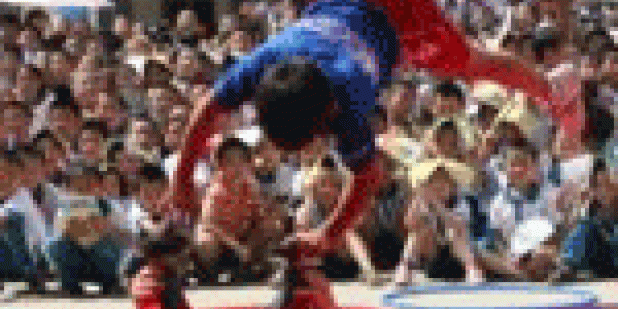Join us for a free one-day workshop for educators at the Japanese American National Museum, hosted by the USC U.S.-China Institute and the National Consortium for Teaching about Asia. This workshop will include a guided tour of the beloved exhibition Common Ground: The Heart of Community, slated to close permanently in January 2025. Following the tour, learn strategies for engaging students in the primary source artifacts, images, and documents found in JANM’s vast collection and discover classroom-ready resources to support teaching and learning about the Japanese American experience.
Smashing Barriers…

By Ying Jia Huang
Loud cheering and applause filled the grounds of Xiamen’s Jimei University as the athletes completed their final routine. After many sets of well choreographed routines that consisted of cartwheels, gymnastics moves, somersaults, handsprings and tosses into the air, the Barrier Breakers once again opened people’s eyes to the extraordinary things that a group of disabled people could do. “We may not be able to do everything the same way as the able can do, but we can always find another way,” said Zach Williams. A coordinator in USC’s Office of International Services, Williams was one of the Americans performing in Xiamen with Barrier Breakers.
Barrier Breakers is a performing troupe that is part of a nonprofit organization called Break the Barriers. This Fresno-based organization was established in 1985 by former gymnast Deby Hergenrader and her husband, former baseball player Steve Hergenrader, to change common perceptions of disability. Inspired by her younger sister who had Down syndrome, Deby seeks to foster mutual understanding between the able and disabled through a common appreciation for sports. Break the Barriers has become the nation’s premier sports-arts center bringing disabled and able people together through arts, fitness, and athletic programs. Williams, who was born without tibia bones, had his knees amputated after his first birthday. However, this never discouraged him from doing the things he loved such as wrestling, hiking, surfing and skateboarding. He wrestled in junior high and high school and although he lost the first few times, he preserved and learned how to use his strength wisely and was able to win subsequent matches. In the yearly “jogathons” in elementary school, he would sit on his skateboard and push himself with his hands to complete the race with his classmates. His love for sports led him to join Break the Barriers in high school where his upper body strength allowed him to excel in gymnastics. He eventually became a coach of the performing team during his sophomore year.
Earlier this year, the Barrier Breakers were invited by the Chinese Department of Disabled Services to help launch China’s first National Day for the Disabled in Xiamen on May 20. Williams and 24 teammates trained to prepare for what would be intense and tight schedule of performances throughout Xiamen’s churches, universities, schools and even at the city mayor’s beachside show. Although the performances at times tested the group’s strength, the team found it worthwhile as they were able to successfully promote the message that there is a commonality between the able and the disabled, that there is always a “magic in the mixture.”
Spreading hope to individuals with disabilities while educating the public is an important and meaningful issue. According to the Second China National Sample Survey on Disability conducted by China’s National Bureau of Statistics, the number of people with disabilities in China is rising. There are 82.96 million persons with different types of disability living in China, with the Sichuan province having the highest in number (6.22 million). Governments at several levels are implementing medical programs and services to assist the disabled. 
The Barrier Breakers hope to raise awareness of this growing number of disabled persons as well as highlight the contributions that the disabled can make to society. Integration, encouragement, and inspiration are key messages the team wishes to deliver to its audience during each performance. For Williams, the greatest reward is the “camaraderie” that is evident between the performers and the audience, the “feeling of barriers breaking.” Williams recalls how one man approached the team after its performance at Jimei University. The man realized that if people with disabilities are able to accomplish such extraordinary feats, he should be able to overcome his own less significant problems and obstacles in life. He, like many others in the audience, walked away from the performance with a greater appreciation for the talents of the disabled, a greater understanding of the need to fully integrate the disabled into society, and also a sense of hope and inspiration to overcome his own disabilities. The Barrier Breakers continually show that cultural or disability barriers can be overcome and that we all ultimately share commonalities.
Other reports:
"Williams Takes Tumbling Talent to China," USC Chronicle, http://www.usc.edu/uscnews/stories/14201.html (September 6, 2007)
残疾人在线 (Handicapped Online): http://www.1203.org/ShowArticle.asp?ArticleID=6120 (May 21, 2007)
厦门市爱华双语幼儿园 (Xiamen Love China Bilingual Kindergarten): 厦门市爱华双语幼儿园 (May 30, 2007)
******
Ying Jia Huang is a sophomore at USC, triple majoring in International Relations, East Asian Languages and Cultures, and History.
Featured Articles
Please join us for the Grad Mixer! Hosted by USC Annenberg Office of International Affairs, Enjoy food, drink and conversation with fellow students across USC Annenberg. Graduate students from any field are welcome to join, so it is a great opportunity to meet fellow students with IR/foreign policy-related research topics and interests.
RSVP link: https://forms.gle/1zer188RE9dCS6Ho6
Events
Hosted by USC Annenberg Office of International Affairs, enjoy food, drink and conversation with fellow international students.
Join us for an in-person conversation on Thursday, November 7th at 4pm with author David M. Lampton as he discusses his new book, Living U.S.-China Relations: From Cold War to Cold War. The book examines the history of U.S.-China relations across eight U.S. presidential administrations.




